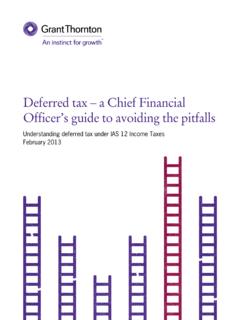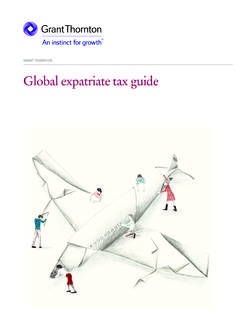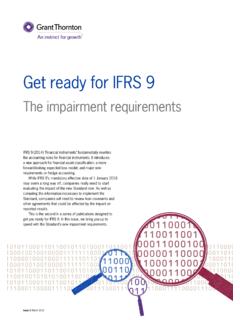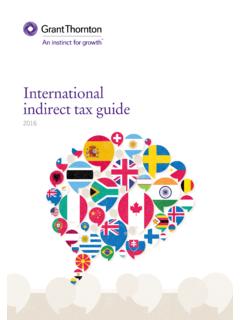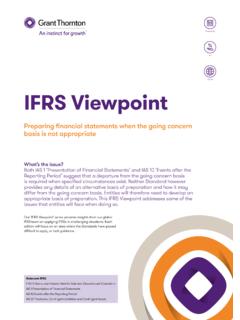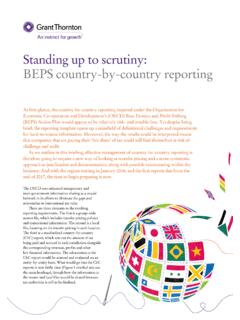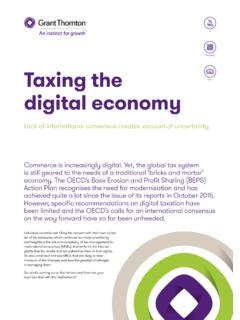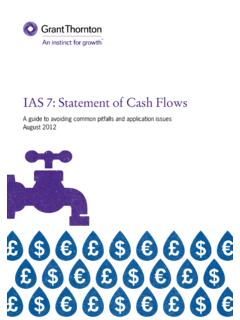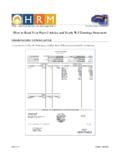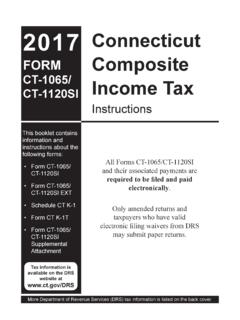Transcription of IFRS Viewpoint - grantthornton.global
1 Potential accounting consequences of the US tax reform for ifrs preparersIFRS ViewpointGlobalAccountingTa xRelevant IFRSIAS 1 Presentation of Financial StatementsIAS 8 Accounting Policies, Changes in Accounting Estimates and ErrorsIAS 12 Income TaxesIFRIC 23 Uncertainty over Income Tax TreatmentsOur ifrs Viewpoint series provides insights from our global ifrs Team on applying IFRSs in challenging situations. Each edition will focus on an area where the Standards have proved difficult to apply or lack s the issue?On 22 December 2017, the President of the United States (US) signed into law the Tax Cuts and Jobs Act (Act). The Act is a sweeping reform of US taxation which is likely to have a significant impact on financial statements prepared under ifrs for entities with US operations.
2 Furthermore, because the Act became law on 22 December its effects must be included in interim and annual reporting periods that include that date. The range and complexity of the Act means that companies with US operations need to analyse the impact of the Act in detail. This ifrs Viewpoint addresses some of the issues that entities will face when doing 22 December 2017, the President of the United States signed into law what is commonly known as the Tax Cuts and Jobs Act . The Act is the most comprehensive reform of US taxation since 1986 and makes sweeping changes to both individual and corporate among the changes is the reduction in the US corporate tax rate from 35% to 21%.
3 There are however a number of other changes which are aimed at encouraging economic growth and reducing the incentives for US companies to shift their tax base to low- or no-tax jurisdictions. We discuss a number of these areas in our publication and set out our views on the financial reporting issues arising from Act is a complex piece of legislation and ifrs preparers with operations in the US will need to spend a considerable amount of time analysing it in order to understand how it may impact accounting for income taxes in their financial statements. Furthermore, because the Act became law on 22 December its effects must be included in interim and annual reporting periods that include that date.
4 With many companies preparing financial statements for annual reporting periods ended 31 December 2017, this could have a potentially material impact due to both the complexity of the Act and the difficulty of gathering information in relation to some aspects of 2 ifrs Viewpoint 8: February 2018 IAS 12 Income Taxes contains the following accounting requirements for current tax and deferred taxCurrent tax is measured at the amount expected to be paid to (or recovered from) the taxation authorities, using the tax rates (and tax laws) that have been enacted or substantively enacted by the end of the reporting tax Deferred tax assets and liabilities are measured at the tax rates that are expected to apply in the period in which the asset is realised or the liability is settled, based on tax rates that have been enacted or substantively enacted by the end of the reporting tracing Under IAS 12, current tax and deferred tax must be recognised outside profit or loss if the tax relates to items that are recognised outside profit or loss (a process known as backwards tracing ).
5 Therefore, current tax and deferred tax that relates to items that are recognised, in the same or a different period:a in other comprehensive income, shall be recognised in other comprehensive income b directly in equity, shall be recognised directly in 12 s requirements Our view In the case of the Tax Cuts and Jobs Act it is clear that the law was enacted on 22 December 2017. We expand on the effects of this in the table on the following pages. ifrs Viewpoint 8: February 2018 3 4 ifrs Viewpoint 8: February 2018 TopicDrop in corporate tax rate 100% capital allowances Repeal of Alternative Minimum Tax (AMT) Net Operating Losses (NOL) Limitation on interest deductions for tax purposesPotential financial statement impactThe reduced tax rate will have an impact on current tax from 1 January 2018.
6 Entities that do not have a 31 December reporting date will be subject initially to a pro-rated or blended tax rate, based on the ratio of days in the tax year that occur before and after the effective discussed above, IAS 12 requires deferred tax assets and liabilities to be measured at the tax rates that are expected to apply to the period when the asset is realised or the liability is settled, based on tax rates (and tax laws) that have been enacted or substantively enacted by the end of the reporting period. The change will therefore impact the measurement of deferred tax in reporting periods ended 31 December 2017. Entities with a non-calendar reporting period will need to consider whether temporary differences reverse during a period when a pro-rated tax rate applies.
7 Companies will need to determine whether capital expenditures made after 27 September 2017, qualify for immediate expensing and consider the effect of the relief on any current and deferred tax balances as a result of this accelerated should consider the implications that the increased bonus depreciation will have on the realisability of any resulting deferred tax assets. Accelerated depreciation may create or increase NOL carryforwards and may also create taxable temporary differences that may be considered a source of income for purposes of assessing the realisability of deferred tax tax assets that previously went unrecognised should now be reassessed given the carryforwards are expected to be fully refunded.
8 Companies will need to reassess the recoverability of deferred tax assets arising from NOL and make adjustments if it is more likely than not that all or a portion of their deferred tax assets will not be realised. Significant changes to the NOL carryforward that may impact a company s reassessment would include (1) elimination of the carrybackperiod and (2) the indefinite carryforward period. Companies would include the tax effect of disallowed current-year interest, as a result of the limitations on net interest deductibility, in their estimated annual effective tax ability to carry forward interest not recovered could potentially create additional deferred tax assets which will in turn need to be assessed for recoverability.
9 (continued)Key provisions of the Act for corporate entities SummaryPerhaps the biggest impact to companies is the reduction in the US corporate tax rate from 35% to 21%. This is effective from 1 January 2018 regardless of the reporting entity s reporting period. The Act creates 100% first year relief for capital expenditure for all expenditure on assets acquired and placed into service after 27 September 2017 up to the end of 2022. The relief will then be phased out over a period of five years. AMT has been repealed for years beginning on or after 1 January 2018. AMT carryforwards can be offset against regular tax through 2020, while entities may claim a refund for any remaining balances in 2021, regardless of whether an income tax liability exists.
10 NOL created before 1 January 2018, typically have a carryback period of two years and a carryforward period of twenty , NOL created after 2017 can be carried forward indefinitely but cannot generally be carried back. NOL are also limited to 80% of taxable income for losses arising in tax years beginning after Act limits the deduction for net interest to 30% of adjusted taxable income for tax years beginning after 31 December 2017. Interest not recovered in the year in which it is incurred can be carried forward indefinitely. TopicBase Erosion Anti-Abuse Tax (BEAT) Global Intangible Low-Taxed Income (GILTI) Foreign-derived intangible income (FDII) Replacement of a worldwide system of taxing US corporations with a territorial system Repatriation transition taxPotential financial statement impactUS entities making base erosion payments that will be subject to the BEAT should consider the impact on their effective tax is intended to be an incremental tax, meaning that an entity can never pay less than the statutory tax rate of 21%.
